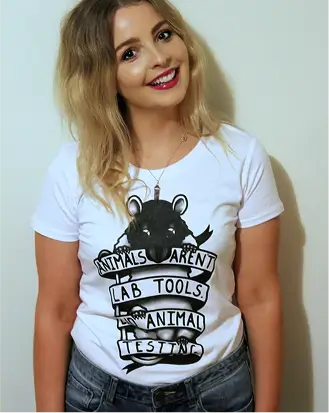For People
As much as we want to end animal experimentation to protect animals, we also want to help protect people by advocating for the use of high-quality and scientifically viable research and testing methods.
Ending animal experimentation would benefit people in many ways…
1. DRUG TRIALS ON ANIMALS REGULARLY FAIL TO PREDICT NEGATIVE EFFECTS IN PEOPLE.
In fact, animal testing fails over 90% of the time!
Animal tests (preclinical trials) are sometimes conducted to try and prevent dangerous or ineffective new drugs from reaching human trials (clinical trials).
However, there is a lot of robust scientific evidence proving that this isn’t working:
- When looking at the success rates of clinical trials for the years 2010 to 2017, a study found a maximum success rate for anti-infectives (agents that fight infections) of 16% and a mere 3% success rate for drugs aimed at the nervous system.1
- Animal testing was deemed as a barrier to effective research due to the low 10% success rate of new drugs making it to human trials.2
- Given the large amount of research on animals being undertaken, some findings will extrapolate to humans just by chance.3
- Of 101 studies involving animal experimentation, only 5 led to licensed human medication. Only one of those proved to have an extensive clinical advantage.4
Find more facts about animal testing failing over 90% of the time here.
Animal experiments failing to detect when compounds are toxic to humans have caused disasters in the past (and will likely cause more in the future). Examples include:
- Thalidomide (a sedative used for treating morning sickness) resulted in 8,000 to 12,000 babies being born deformed, of whom only 5,000 survived past childhood.5 It was approved after safety testing on animals, many of which did not react with deformations even at doses ten times higher than what was given to humans.6
- TGN1412 was meant to be a treatment for a form of blood cancer. A low-dose trial in six healthy volunteers resulted in life-threatening complications within hours.7
- Fialuridine proved effective in treating Hepatitis B and safe in mice, rats, monkeys, and dogs. Human trials resulted in ten deaths that could not have been prevented according to an investigation.8
- Vioxx was approved for relieving arthritis symptoms, and it showed no issues during long-term tests with rats, mice and dogs.9 Until its market withdrawal it had caused 88,000 to 139,000 heart attacks and strokes, resulting in at least 28,000 deaths.10
- Liver toxicity that was not detected during preclinical animal tests or clinical trials is one of the main reasons that drugs are withdrawn from the market.11
2. PEOPLE CONDUCTING EXPERIMENTS CAN SUFFER TOO
- Researchers performing harmful procedures on animals often find it hard (emotionally). The psychological burden can significantly impact their well-being.12
- As we know from our struggle to get information about animal experiments released to the public, researchers conducting animal experiments can be terrified of public scrutiny. Not only are they at risk of harassment and becoming targets of personal attacks. They also can not openly talk about their work and may worry about their confidentiality restrictions.
- Researchers working with animals regularly form a bond with them and are affected by the animal’s level of stress or pain. Yet, the social stigma related to their kind of work often results in low social support, which increases traumatic stress and burnout risk.13
- Having to kill animal you care about is associated with work-to-family conflict, depressive moods, and substance use.14
- Animal researchers often subconsciously cope with cognitive dissonance.15
- While only a relatively small percentage of animal researchers have been affected by animal rights activism, violent protests do occur, making animal researchers, in general, feel more unsafe.16
We want to emphasise here that NZAVS is a peaceful organisation, and we do not condone violence or abuse of any kind, verbal or otherwise.
3. ANIMAL DISSECTIONS IN SCHOOLS ARE PROBLEMATIC AND UNNECESSARY
- Alternative methods of teaching anatomy and physiology are conveying the knowledge better and more ethically than dissection classes.17,18
- Teaching that animals are not lab tools encourages young people to have compassion for animals instead of having to develop coping strategies to deal with ethical concerns.19
- It has been shown that mandatory dissections in school can turn compassionate people away from a career in science.20
- Kind education methods have shown positive effects on learning and motivation.21
4. ANIMAL MODELS ARE FAULTY
Animals are used in countless ways to try and model us humans. The obvious problem is that they are not tiny humans. There are substantial differences in the way our bodies work which causes animal models to give faulty results.
Examples include:
- Rats and mice are commonly used as models in cancer research, but there are numerous differences in the way cancer tissue grows and how their bodies react to cancer-causing chemicals compared to humans.22
- For example, rats do not have increased tumour risk when given arsenic for two whole years.23
- Rats need to inhale 300 times the asbestos necessary to cause cancer in humans to show an effect.24
- Monkeys tolerate Paracetamol perfectly finely in doses that would cause lethal liver failure in humans.25
- Diabetes models using rodents are highly likely to fail, as their glucose metabolism and genetic insulin encoding are drastically different to ours.26
- Models for wound healing commonly use rodents or pigs. Their skin, hair growth, sweat glands and healing mechanisms are too different to be easily translatable, leading to wound therapies often working in one and not the other.27
- Using animals, particularly young healthy mice as models for eye conditions not only ignores the fact that many eye diseases are age-related,28 but also disregards our anatomical differences.29
- Genomic inflammatory responses are vastly different between mice and humans, making them an inaccurate model for inflammation research.30
- Chimpanzees and macaques, the animals used to model HIV infection, react differently to the virus than us. This is why, with over 85 HIV vaccines for them, we humans still have none.31
- Animal models of Multiple Sclerosis have been unsuccessful in producing a cure, as MS is unique to humans. The commonly used rodents don’t get it, and even after messing with their genetics, none display all relevant symptoms.32
- Rodent models for the human brain are problematic as their neurons work differently to humans,33 the responsible genes, gene expressions and involved cell types are different.34
- A whole group of chemicals (called MMP Inhibitors) has been showing great success against aggressive cancers in animal models since the 1980s. But none of them has made it through clinical trials on humans, causing more damage than good if they even worked.35
- A study comparing 25 wound therapies in humans against pigs and small mammals found that the animal experiments agreed with the human results 78% of the time for the pig, 53% for the small-mammal, and 57% for in vitro studies, respectively.36 Pure chance would be 50%.
Not only are our differences regularly causing new medicines to fail, but who knows how many life-saving drugs we abandoned, just because they did not work in animal tests?
- Had Penicillin been tested on guinea pigs or hamsters, we would have never used antibiotics, as Penicillin is toxic to them.37
- Had Alteplase (a treatment for heart attacks and currently the one drug helping in the early stages of stroke)38 been tested on pigs, it would have been abandoned. Pigs are missing a specific protein needed for it to work.39
- Luckily, neither Ibuprofen nor aspirin was tested on cats and dogs, or we wouldn’t have them today.40
- Tamoxifen was approved as a treatment for breast cancer before tests on mice and rats were mandatory. Thankfully, as it causes liver tumours in rats41 and faster tumour growth in mice.42
- https://doi.org/10.1038/d41573-019-00074-z
- https://doi.org/10.1111/basr.12134
- https://doi.org/10.1136/bmj.g3387
- https://doi.org/10.1016/s0002-9343(03)00013-5
- https://doi.org/10.5840/jpsl20111133
- https://doi.org/10.1016/S1054-3589(08)60101-5
- http://doi.org/10.1056/NEJMoa063842
- http://www.nap.edu/catalog/4887.html
- https://www.accessdata.fda.gov/drugsatfda_docs/nda/99/021042_52_Vioxx.cfm
- https://www.finance.senate.gov/hearings/fda-merck-and-vioxx-putting-patient-safety-firstd
- https://doi.org/10.1186/s12916-016-0553-2
- https://doi.org/10.1136/medethics-2020-106945
- https://doi.org/10.3389/fvets.2020.00114
- https://doi.org/10.1111/j.1559-1816.2005.tb02096.x
- https://doi.org/10.30802/AALAS-JAALAS-19-000073
- https://doi.org/10.1038/470452a
- https://doi.org/10.3390/ani11010114
- https://doi.org/10.1525/abt.2022.84.7.399
- https://doi.org/10.1177/089124197026001002
- https://doi.org/10.2307/4448624
- https://www.proquest.com/openview/e110dfbfb35899015de728ce247a0d94/1?pq-origsite=gscholar&cbl=18750&diss=y
- https://www.ncbi.nlm.nih.gov/books/NBK570327/
- https://doi.org/10.1016/0041-008X(67)90135-4
- https://doi.org/10.1093/annhyg/39.5.715
- https://doi.org/10.3109/00498254.2014.973000
- https://doi.org/10.14573/altex.1309231
- https://doi.org/10.1046/j.1524-475x.2001.00066.x
- https://doi.org/10.1016/S0140-6736(18)31550-2
- https://doi.org/10.1167/iovs.63.9.11
- https://doi.org/10.1073/pnas.1222878110
- https://doi.org/10.1177%2F026119290803600403
- https://doi.org/10.1038/nn.3168
- https://doi.org/10.1002/jcb.25312
- https://doi.org/10.1038/s41586-019-1506-7
- https://doi.org/10.1038/sj.bjc.6603043
- https://doi.org/10.1046/j.1524-475x.2001.00066.x
- https://pubmed.ncbi.nlm.nih.gov/4446629
- https://doi.org/10.3390/ijms23158367
- https://doi.org/10.4103/1673-5374.274324
- https://doi.org/10.1016/j.cvsm.2012.01.003
- https://aacrjournals.org/cancerres/article/53/17/3919/499203/Two-Year-Carcinogenicity-Study-of-Tamoxifen-in
- https://aacrjournals.org/cancerres/article/44/9/4006/488843/Estrogen-like-Effects-of-Tamoxifen-on-Human





